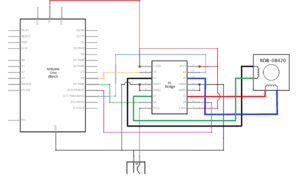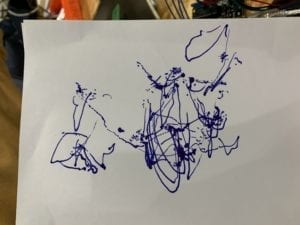Materials:
For Steps 1 and 2
1 * 42STH33-0404AC stepper motor
1 * L293D ic chip
1 * power jack
1 * 12 VDC power supply
1 * Arduino kit and its contents
For Step 3
2 * Laser-cut short arms
2 * Laser-cut long arms
1* Laser-cut motor holder
2 * 3D printed motor coupling
5 * Paper Fasteners
1 * Pen that fits the laser-cut mechanisms
Paper
Stepper Circuit

This circuit was relatively simple for us. We were definitely worried that the outside power source would fry our computer, but it only gave us more motivation to work carefully. The code can be found here.
Stepper Circuit with Potentiometer
We added a potentiometer to our circuit and used the MotorKnob code.
Drawing Machine

We used the following code:
/*
* MotorKnob
*
* A stepper motor follows the turns of a potentiometer
* (or other sensor) on analog input 0.
*
* http://www.arduino.cc/en/Reference/Stepper
* This example code is in the public domain.
*/
#include <Stepper.h>
// change this to the number of steps on your motor
#define STEPS 200
// create an instance of the stepper class, specifying
// the number of steps of the motor and the pins it's
// attached to
Stepper stepper(STEPS, 8, 9, 10, 11);
// the previous reading from the analog input
int previous = 0;
void setup() {
// set the speed of the motor to 30 RPMs
stepper.setSpeed(30);
}
void loop() {
// get the sensor value
int val = analogRead(0);
map(val, 0, 1023, 0, 200);
// move a number of steps equal to the change in the
// sensor reading
stepper.step(val - previous);
// remember the previous value of the sensor
previous = val;
}
Question 1: What kind of machines would you be interested in building? Add a reflection about the use of actuators, the digital manipulation of art, and the creative process to your blog post.
I’m really interested in fitness technology, particularly the kind that can also have an environmental impact. For example, there are cycling classes all around the world. I think it would be a great opportunity to harness the kind of movement that is already taking place and use it as kinetic energy. In this sense, the cyclists could be the actuators. This kind of project would feel less like an art project, but I feel like there is art in the design of the machine itself. To be able to digitally manipulate a commonplace object and give it a greater purpose would be a great achievement.
Question 2: Choose an art installation mentioned in the reading ART + Science NOW, Stephen Wilson (Kinetics chapter). Post your thoughts about it and make a comparison with the work you did during this recitation. How do you think that the artist selected those specific actuators for his project?
I particularly like Landon Fieldwork’s “Gastarbyter.” As someone who talks a lot, maybe too much, I have always reminded myself of Ram Dass’ quote, “the quieter you become, the more you can hear.” I like the statement Fieldwork is making regarding out society and the kinds of interactions we are constantly engaging in and those that we are lacking. This experience is interesting because it appears to be very simple and potentially not very interactive, but the kind of interaction that’s taking place is just not as mainstream. I like that users are compelled to simple sit and feel and listen and this definitely influenced his decision to use less “flashy” actuators. Our drawing machine was very fun to make, but was less purposeful. For us, a loud, stepper motor with crunchy plastic pieces was of no consequence.